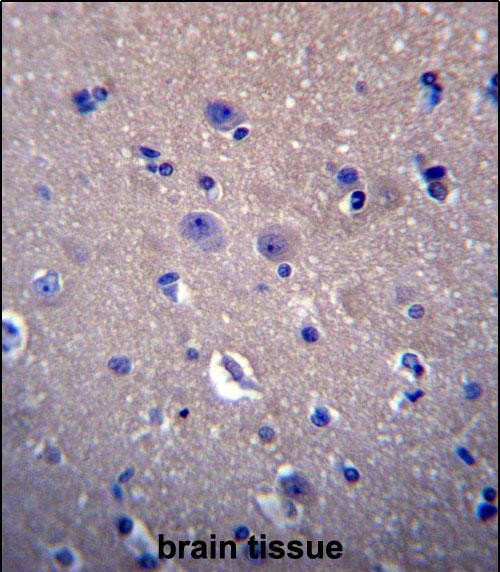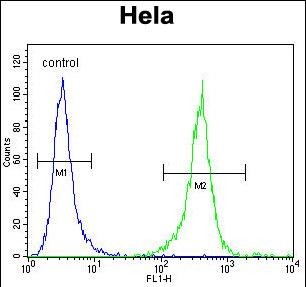DNAJB6 Antibody (Center)
Affinity Purified Rabbit Polyclonal Antibody (Pab)
- 产品详情
- 实验流程
- 背景知识
Application
| WB, IHC-P, FC, E |
|---|---|
| Primary Accession | O75190 |
| Other Accession | NP_490647.1, NP_005485.1 |
| Reactivity | Human |
| Host | Rabbit |
| Clonality | Polyclonal |
| Isotype | Rabbit IgG |
| Calculated MW | 36087 Da |
| Antigen Region | 218-247 aa |
| Gene ID | 10049 |
|---|---|
| Other Names | DnaJ homolog subfamily B member 6, HHDJ1, Heat shock protein J2, HSJ-2, MRJ, MSJ-1, DNAJB6, HSJ2, MRJ, MSJ1 |
| Target/Specificity | This DNAJB6 antibody is generated from rabbits immunized with a KLH conjugated synthetic peptide between 218-247 amino acids from the Central region of human DNAJB6. |
| Dilution | WB~~1:1000 IHC-P~~1:100~500 FC~~1:10~50 E~~Use at an assay dependent concentration. |
| Format | Purified polyclonal antibody supplied in PBS with 0.09% (W/V) sodium azide. This antibody is purified through a protein A column, followed by peptide affinity purification. |
| Storage | Maintain refrigerated at 2-8°C for up to 2 weeks. For long term storage store at -20°C in small aliquots to prevent freeze-thaw cycles. |
| Precautions | DNAJB6 Antibody (Center) is for research use only and not for use in diagnostic or therapeutic procedures. |
| Name | DNAJB6 |
|---|---|
| Synonyms | HSJ2, MRJ, MSJ1 |
| Function | Has a stimulatory effect on the ATPase activity of HSP70 in a dose-dependent and time-dependent manner and hence acts as a co- chaperone of HSP70 (PubMed:10954706, PubMed:28233300). Plays an indispensable role in the organization of KRT8/KRT18 filaments (PubMed:10954706). Acts as an endogenous molecular chaperone for neuronal proteins including huntingtin (PubMed:11896048, PubMed:22366786). Suppresses aggregation and toxicity of polyglutamine- containing, aggregation-prone proteins (PubMed:20159555, PubMed:22366786). Also reduces cellular toxicity and caspase-3 activity (PubMed:11896048). |
| Cellular Location | Cytoplasm, perinuclear region. Nucleus Cytoplasm, myofibril, sarcomere, Z line |
| Tissue Location | Widely expressed. Highest levels in testis and brain, and lower levels in heart, spleen, intestine, ovary, placenta, lung, kidney, pancreas, thymus, prostate, skeletal muscle, liver and leukocytes. In testis, expressed in germ cells in the earlier stages of differentiation pathway as well as in spermatids. In brain, expressed at a higher level in hippocampus and thalamus and a lower level in amygdala, substantia nigra, corpus callosum and caudate nucleus |
For Research Use Only. Not For Use In Diagnostic Procedures.
Provided below are standard protocols that you may find useful for product applications.
BACKGROUND
This gene encodes a member of the DNAJ protein family. DNAJ family members are characterized by a highly conserved amino acid stretch called the 'J-domain' and function as one of the two major classes of molecular chaperones involved in a wide range of cellular events, such as protein folding and oligomeric protein complex assembly. This family member may also play a role in polyglutamine aggregation in specific neurons. Alternative splicing of this gene results in multiple transcript variants; however, not all variants have been fully described.
REFERENCES
Mitra, A., et al. J. Biol. Chem. 285(32):24686-24694(2010)
Edo De Bock, C., et al. Int. J. Oncol. 36(5):1155-1163(2010)
Hageman, J., et al. Mol. Cell 37(3):355-369(2010)
Lowe, J.K., et al. PLoS Genet. 5 (2), E1000365 (2009) :
Dey, S., et al. Mol. Cell. Biochem. 322 (1-2), 137-142 (2009) :
终于等到您。ABCEPTA(百远生物)抗体产品。
点击下方“我要评价 ”按钮提交您的反馈信息,您的反馈和评价是我们最宝贵的财富之一,
我们将在1-3个工作日内处理您的反馈信息。
如有疑问,联系:0512-88856768 tech-china@abcepta.com.























 癌症的基本特征包括细胞增殖、血管生成、迁移、凋亡逃避机制和细胞永生等。找到癌症发生过程中这些通路的关键标记物和对应的抗体用于检测至关重要。
癌症的基本特征包括细胞增殖、血管生成、迁移、凋亡逃避机制和细胞永生等。找到癌症发生过程中这些通路的关键标记物和对应的抗体用于检测至关重要。 为您推荐一个泛素化位点预测神器——泛素化分析工具,可以为您的蛋白的泛素化位点作出预测和评分。
为您推荐一个泛素化位点预测神器——泛素化分析工具,可以为您的蛋白的泛素化位点作出预测和评分。 细胞自噬受体图形绘图工具为你的蛋白的细胞受体结合位点作出预测和评分,识别结合到自噬通路中的蛋白是非常重要的,便于让我们理解自噬在正常生理、病理过程中的作用,如发育、细胞分化、神经退化性疾病、压力条件下、感染和癌症。
细胞自噬受体图形绘图工具为你的蛋白的细胞受体结合位点作出预测和评分,识别结合到自噬通路中的蛋白是非常重要的,便于让我们理解自噬在正常生理、病理过程中的作用,如发育、细胞分化、神经退化性疾病、压力条件下、感染和癌症。








